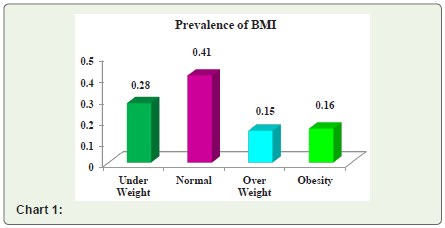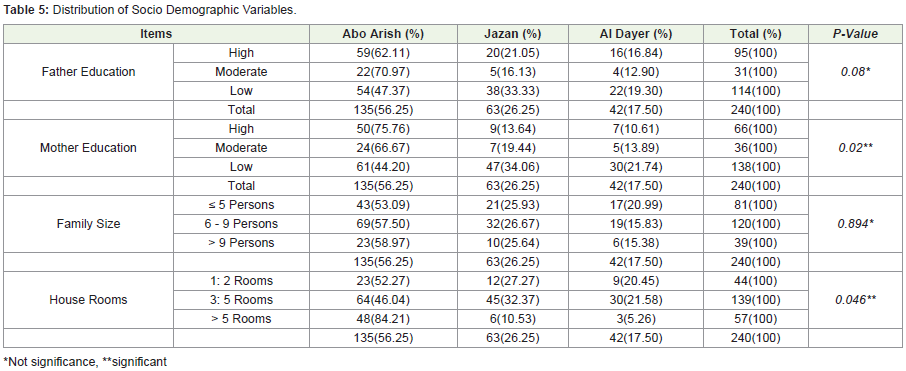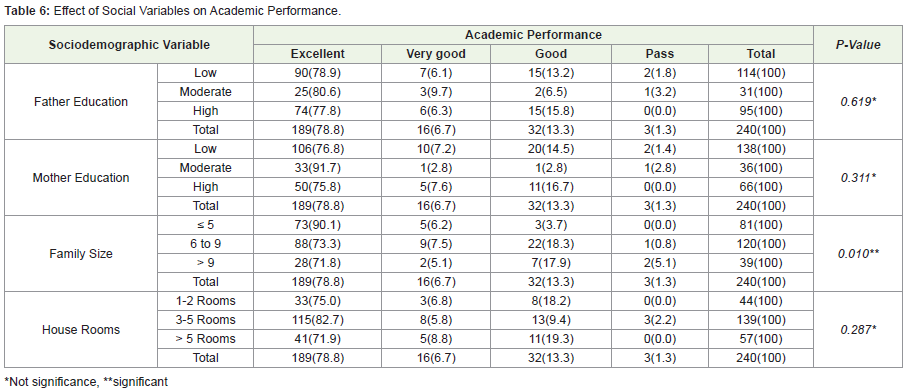Research Article
Anthropometric Parameters and Its Effects on Academic Performance among Primary School Female Students in Jazan, Saudi Arabia Kingdom
Shaban FA, Swaleha N, Chandika RM*, Sahlooli AM and Almaliki SD
Department of Clinical Nutrition, College of Applied Medical Sciences, Jazan University, KSA
Corresponding author: Chandika RM, Clinical Nutrition Department, College of Applied Medical Sciences, Jazan University, KSA, Tel no: +966 536629535; E-mail: ramamohan.chandika@gmail.com
Citation: Shaban FA, Swaleha N, Chandika RM, Sahlooli AM, Almaliki SD. Anthropometric Parameters and Its Effects on Academic Performance among Primary School Female Students in Jazan, Saudi Arabia Kingdom. Indian J Nutri. 2018;5(1): 184.
Copyright © 2018 Shaban FA, et al. This is an open access article distributed under the Creative Commons Attribution License, which permits unrestricted use, distribution, and reproduction in any medium, provided the original work is properly cited.
Indian Journal of Nutrition | ISSN: 2395-2326 | Volume: 5, Issue: 1
Submission: 01/04/2018; Accepted: 25/04/2018; Published: 30/04/2018
Abstract
Background: The prevalence of malnutrition in Saudi children is higher when compared with the countries having less economic resources. All anthropometric indicators were lower in girls when compared to boys. The problem is going to persist unless great effort is kept to improve their nutritional status.
Aim: To investigate the anthropometric parameters status and its effect on academic performance among primary school female students of rural and urban area of Jazan region, Saudi Arabia Kingdom.
Methods: A cross sectional study was conducted among female school children aged from 6 to 12 years at rural and urban area of Jazan region, South Western part of Saudi Arabia. The anthropometric measurements were assessed as Weight for Age Z-Score (WAS) and Height for Age Z-Score (HAZ), Body Mass Index (BMI) was calculated as weight in Kg/height in meter square and standard charts of BMI for age was used as reference. A pre designed questionnaire was used for collecting socioeconomic information include parents education, family size, house size. Scholastic achievement of students was assessed using their grades in three different subjects Arabic, Science and Mathematics.
Results: Among total female students 30.8% were severe underweight (WAZ < 0.85), where as region wise 32.6%, 30.1% and 26.2% from the urban regions Abu Arish, Jazan and the rural region Al Dayer respectively. Average Body Mass Index was 18.3 for the female students from Abu Arish and Al Dayer where as in Jazan female students average Body Mass Index was 17.3. Obesity recorded lower ratio 13.3% and 15.9% for children in urban regions of Abu Arish and Jazan and 23.8% was recorded for children in the rural area of Al Dayer. Approximately 82% of the participants with normal body weight were showing excellent academic performance however it was found 74% of obese participants have got only pass status in the academics. P-Value < 0.01 statistically there was highly significant association between nutritional status and academic performance.
Conclusion: Great effort is still needed to improve the nutritional status of primary school female students in South Western area of Saudi Arabia Kingdom.
Keywords:
Nutritional status; Anthropometric measurements; Academic performance; Female primary school; Jazan area
Introduction
Saudi Arabian government give the most priority for developing the educational level of different Saudi Governorates, furthermore Jazan district in southern area of Saudi Arabia Kingdom has been received the most attention. Several studies have been indicated to the negative effect of poor feeding on children growth and mental development [1]. Malnourished children suffer from slow rate of brain development in form of low brain weight, thin cerebral cortex and decrease number of neurons [2]. Therefore, there is no doubt malnutrition has the greatest effect on academic performance of primary school children [3]. Malnutrition can be quantified using anthropometric measurements as weight for age, height for age and weight for height which are expressed as Z-Score in comparison with standard references [3,4]. Wasting (low body weight) and stunting (low body height) in primary school children was associated with low academic performance [5]. As well, over weight and obese children are more likely to have low self-esteem and depression which cause poor academic achievement [6]. Also academic performance of children are affected by social variables such as household income, parent education level and household size [7,8].
The rate of malnutrition prevalence between Saudi children is still higher than other countries with less economic resource, so great effort is still needed to improve their nutritional status [9]. Physical growth and cognitive development in children are fast and about 92% of adult and intellectual capacity is attained by 13 years old [10]. The study on prevalence of malnutrition in Saudi children conducted in 2010 reported that all anthropometric indicators were lower in girls when compared to the boys [11]. Current study was designed to investigate the anthropometric parameters status in female students and its effect on academic performance and for studying the association between socio demographic variables and academic performance among primary school female students of rural and urban area of Jazan region, Saudi Arabia Kingdom.
Materials and Methods
A cross sectional study was conducted in three primary schools run by the Ministry of Education in Jazan area, south western part of Saudi Arabia. Randomly two schools are selected from urban area of the cities Abu Arish and Jazan and one school randomly selected from the rural area of Al Dayer village. Total 240 female students were participated in this survey. The variable age was categorized into three groups as 6-7, 8-9, and 10-12 years old. Among 240 female students 135 from Abu Arish primary school, 63 students from Jazan primary school and 42 students from Al Dayer primary school. A pre prepared questionnaire was used for collecting socioeconomic information include parents education, family size, house size. Parent education was classified into high (Bachelors of Science or more), moderate (secondary school qualification) and low (essential education).
The anthropometric measurements were assessed according to WHO (1986) where body weight was recorded in Kg., body height in meter. Weight for Age Z-Score (WAZ) and Height for Age Z-Score (HAZ) values were assessed as: actual body weight/ standard body weight of students age, and actual body height/ standard height of age [12]. Weight and height for age Z-score values were used as indicators for nutritional status and classified into severe malnutrition < 0.85, mild malnutrition 0.85 - 0.90, normal 0.90 to 1.1 and over weight > 1.1 [13]. Body Mass Index (BMI) was calculated as weight in Kg/ height in meter square. Standard charts of BMI for age was used as reference standard and the results were classified into four categories as students with BMI < 5th percentile underweight, from 10th to 85th percentile normal weight, from 85th to 95th percentile, over weight and obese was classified as BMI > 95th percentile [14] (Chart 1). Scholastic achievement of students was assessed using their grades in three different subjects, Arabic, Science and Mathematics with score of 100 each and average grade was classified according to the likert 4 point scale into excellent 90 - 100, very good 80 - 89, good 70 - 79 and pass from 60 - 69 mark.
Results
Average body weight and standard body weight among female school children aged from 6 to 12 years in rural and urban area of Jazan region, South Western part of Saudi Arabia Kingdom were 33.44 Kg and 32.06 Kg. respectively. Among the 240 female students from three primary schools 30.8% were severe underweight (WAZ < 0.85), where as region wise 32.6% , 30.1% and 26.2% from the urban regions Abu Arish, Jazan cities and the rural region Al Dayer respectively. P-value > 0.05 statistically not significant (Table 1).
Average height and standard height among female school children aged from 6 to 12 years were 1.35 Mts. and 1.36 Mts. respectively. Among the 240 female students not more than 8% height for age Z-score under moderate category (HAZ range 0.85 - 0.90). More than 90% of students HAS score under normal category (HAZ range 0.9 - 1.1) in the three primary schools. P-value > 0.05 statistically not significant (Table 2).
Body Mass Index values were in parallel with the results of weight for age Z-score. Average body mass index among female school children aged from 6 to 12 years was 18.00. Among the 240 female students from three primary schools 27.5% were underweight (BMI < 0.05), where as region wise 27.3% , 30.1% and 23.8% were underweight (BMI < 0.05) from the urban regions Abu Arish, Jazan cities and the rural region Al Dayer respectively. Obesity (BMI > 0.95) recorded lower ratio 13.3% and 15.9% for children in urban regions Abu Arish and Jazan in comparison with 23.8% in rural area of Al Dayer. P-Value < 0.05 statistically significant effect of students region on the prevalence of underweight (Table 3).
Academic performance varied widely with body mass index it was clearly depicted that academic performance is strongly associated with the body mass index. 82% of the participants with normal body weight are shown to have excellent academic performance followed by 10% of very good performance. In the overweight participants 80% were found to have good academic performance in contrast to the normal participants with 82% of excellent academic performance. Approximately 74% of obese participants have settled with just pass status showing the strong association of nutrition with academic performance (Table 4).
Table 5 shows that socio demographic variables distribution of female school children aged from 6 to 12 years in rural and urban area of Jazan region, South Western part of Saudi Arabia Kingdom. Among the 240 female students from three primary schools most of the students were having low level father education. Region wise 47.37%, 33.33% and 19.30% were having low level father education in Abu Arish, Jazan and Al Dayer respectively. P-value > 0.05 not significant. 44.20%, 34.06% and 21.74% were having low level mother education respectively. P-Value < 0.05 significant. More than 50% of the students having the family size 6-9 persons. P-value > 0.05 not significant. 44.2% of students were having 3 to 5 house rooms. P-value < 0.05 significant.
Table 6 shows that relationship between socio demographic variables with academic performance, There is a clear effect of parent’s education levels on academic performance but statistically poor significant. Among the high level education category fathers, 78% of students have excellent performance. Among low level education mothers, 2% of students settled with pass. Family size has significant effect on academic performance p-value < 0.05. whereas house size not shown any significant affect on academic performance.
Discussion
Among the 240 female students from three primary schools 30.8% were severe underweight (WAZ < 0.85), where as region wise 32.6%, 30.1% and 26.2% from Abu Arish, Jazan cities and Al Dayer village respectively. Present study reveals that 91% of primary female school children from age 6-12 years were normal height. Parallel results indicated that 60.7% of Saudi female children were in normal height for age, 28% was taller and only 11% were stunted in the study conducted by Hassan Mazher Bukhari on anthropometric Measurements and the Effect of Breakfast Sources in School Achievement, Physical Activity and Dietary Intake for 6-13 Years Old Primary School Children Girls in Makkah City, kingdom of Saudi Arabia [9].
Present study results are co-inside with study by Mouzan, et al. stated that obesity prevalence between Saudi Arabia students in different ages was 9.3% and present study stated that obesity prevalence among female school children aged from 6 to 12 years in rural and urban area of Jazan region was 15% [15].
Present study results depict academic performance varied widely with body mass index. Academic performance is strongly associated with the body mass index. 82% of the participants with normal body weight are shown to have excellent academic performance followed by 10% of very good performance. In the overweight participants 80% were found to have good academic performance in contrast to the normal participants with 82% of excellent academic performance. Approximately 74% of obese participants have settled with just pass status showing the strong association of nutrition with academic performance. Nike SR, et al. reported that, under nutrition is associated with lower academic achievement of primary school students [4]. Anonymous stated that good nutrition status is needed to high academic performance because nutrition affects intellectual development and learning ability.
In the current study parent education level shows no significant effect on student’s academic performance and most of the students with low level of father and mother education. The current findings same as the study conducted by Zeru, et al. stated that highly educated parents have a better knowledge of children requirements for good academic performance [3].
Conclusion
Academic performance is strongly associated with the body mass index. Participants with normal body weight are shown to have excellent academic performance and obese participants have settled with just pass status showing the strong association of nutrition with academic performance. Parent education has no significant effect and family size has significant effect on academic performance of children. Great effort is still needed to improve the nutritional status of primary school female students in South Western area of Saudi Arabia Kingdom.
Acknowledgement
The current research has been funded by Jazan University, Deanship of Scientific Research, Future Scientists Program. So, I would like to express my deep gratitude to the Dean and Vice-Dean of Scientific Research. Also I would like to extend my thanks to the staff of Scientific Research Deanship for their kindly support.
References
- Mendez MA, Adair LS (1999) Severity and timing of stunting in the first two years of life affect performance on cognitive tests in late childhood. J Nutr 129: 1555-1562.
- Shashidhar HR (2017) Malnutrition. Medscape.
- Zeru S, Mulugeta A, Gebretsadik T (2017) Assessment of nutritional status and other factors correlates with academic performance of lower primary school children from Mekelle, Northern Ethiopia. Research & Reviews: J Comput Biol 6: 1-11.
- Naik SR, Itagi SK, Patil M (2015) Relationship between nutrition status, intelligence and academic performance of Lambani school children of Bellary district, Karnataka. Int J Farm Sci 5: 259-267.
- Ong LC, Chandran V, Lim YY, Chen AH, Poh BK (2010) Factors associated with poor academic achievement among urban primary school children in Malaysia. Singapore Med J 51: 247-252.
- Taras H, Potts-Datema W (2005) Obesity and student performance at school. J Sch Health 75: 291-295.
- Vernon PA, Wickett JC, Bazana PG, Stelmack RM (2000) The neuropsychology and psychophysiology of human intelligence. Handbook of intelligence (Sternberg RJ edn). Cambridge University Press, New York.
- Wickett JC, Vernon PA, Lee DH (2000) Relationship between factors of intelligence and brain volume. Personality and Individual Difference 29: 1095-1122.
- Bukhari HM (2013) Anthropometric measurements and the effect of breakfast sources in school achievement, physical activity and dietary intake for 6-13 years old primary school children girls in Makkah City. Int J Nutr and Food Sci 2: 272-279.
- Toga AW, Thompson PM, Sowell ER (2006) Mapping brain maturation. Trends Neurosci 29: 148-159.
- El Mouzan MI, Foster PJ, Al Herbish AS, Al Salloum AA, Al Omar AA, et al. (2010) Prevalence of malnutrition in Saudi children: a community-based study. Ann Saudi Med 30: 381-385.
- WHO (1986) Use and interpretation of anthropometric indicators of nutritional status. WHO Working Group. Bull World Health Organ 64: 929-941.
- Mclaren DS, Read WC (1975) Weight/length Classification of Nutritional Status. The lancet 306: 219-221.
- Agarwal KN, Saxena A, Bansal AK, Agarwal DK (2001) Physical growth assessment in adolescence. Indian Pediatr 38: 1217-1235.
- El Mouzan MI, Al Herbish AS, Al Salloum AA, Foster PJ, Al Omer AA, et al. (2011) Prevalence of short stature in Saudi children and adolescents. Ann Saudi Med 31: 498-501.
- Anonymous (1990) Nutrition and the school-aged child. UN/ACC/SCN (United Nations-Administrative Committee on Coordination- Subcommittee on Nutrition). SCN News No 16, Electronic version.







